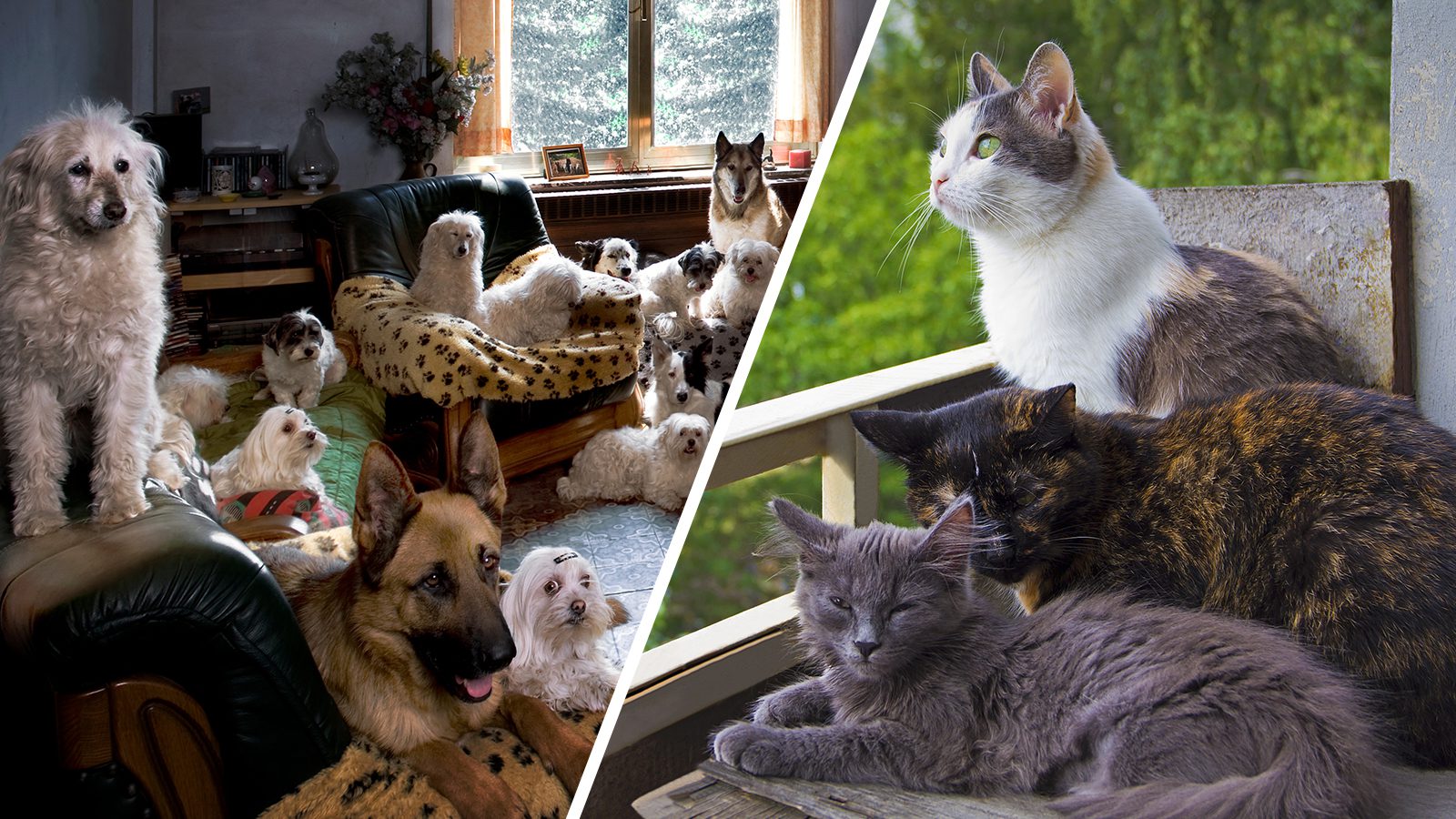Animal hoarding, also known as Noah syndrome, involves the accumulation of many pets to the point where an animal hoarder cannot care for them. This is accompanied by an inability to comprehend or perceive the damage and harm caused by their behavior. This is occasionally considered a symptom of mental illness, but “Hoarding Disorder” is also diagnosable.
There is a broad, complex range of factors that can be involved in the existence of animal hoarding behavior:
- Addiction or dementia.
- Compulsion, low self-esteem, or unhealthy attachment to animals.
- Delusion can be a defense mechanism. It can also stem from more sinister disorders involving zoophilia.
But just because someone has many pets doesn’t mean they are an animal hoarder. Some people can healthily care for many pets. So, how can you differentiate pet ownership from hoarding, and at what point does it become a problem? Here are four red flags that a pet owner has become an animal hoarder.
1 – An Animal Hoarder Exhibits Highly Secretive Behavior
Many psychiatric and psychological issues worsen because of the emotions of shame and guilt that the sufferer of these problems feels. As a result, they don’t want to talk to others about their issues for fear of judgment. This forms a downward spiral that leads to steadily worsening conditions and, further, continued isolation. This same pattern occurs with animal hoarders.

How Someone Starts Hoarding Pets
There are three common pathways into animal hoarding, namely:
- A typical, loving pet owner who becomes overwhelmed by a changing life circumstance can no longer keep up with their pets’ needs.
- A person who wants to help and rescue animals feels it is their mission to do so, even when they can no longer feasibly take on additional pets.
- An individual who cruelly seeks to exploit animals for their gain and therefore does not care about the welfare of each animal.
The first two of the pathways mentioned above start with good intentions. However, these individuals, especially those following the first pathway, will feel embarrassed when their situation spirals out of control. This causes them to become very secretive. They believe they’ll be able to get things back in hand with enough time and don’t want anyone to see their home until they’ve fixed the problem.
Someone Hoarding Pets Will Keep It A Secret
Unfortunately, for most people who have fallen into hoarding this way, the longer they refuse to ask for help, the worse things get; ultimately, nothing ever gets fixed. If a pet owner has grown secretive about their homes, pets, and situation, it could be a red flag that they’ve become an animal hoarder. Typical forms of secretive behavior include:
- Closing the curtains or blinds at all times
- Refusing to allow anyone into their home
- Being cautious about opening the door too wide when leaving or entering the house
- Glancing around worriedly before opening the doors
- Being mean or cruel to drive away concerned individuals who want to come in
2 – An Animal Hoarder Has A Home In Disrepair
Animal hoarders have little time and energy to care for the increasing number of pets in their homes. As a result, what starts as a mildly messy space soon devolves into a constant buildup of dirt, grime, animal waste, and other issues. This ultimately causes a house to deteriorate. This may be because of any or all of the following reasons.
- Pets may become anxious and stressed or lack training in their poor home environments. These can all lead to destructive behavior. Animals might destroy furniture, tear fabrics like curtains, and chew on wall skirtings and furniture.
- Animal waste is left to stink up the home, uncleaned, leading to the discoloration and deterioration of the items it touches. This also attracts bugs, such as flies and other pests.
- A lack of willingness to let people into the home means that professionals can’t come in to fix things in or around the house.
- A lack of funds, time, and energy means the house never gets cleaned, and problems are never fixed. This eventually leads to an overwhelming to-do list, and an animal hoarder will be unable to attend to the ever-growing chores.
Red Flags That Give Away The Home Of An Animal Hoarder
The problem is that it’s hard to spot these red flags when an animal hoarder is unlikely to let you view the inside of their home. Still, there are some common signs that you can look out for. Some of these are as follows.
- You may see torn curtains in the windows.
- The house’s interior can be messy or dirty.
- Lights are rarely on due to an inability to pay utility bills.
- The exterior of the house used to be clean but now appears unmaintained.
- Metal fixtures on the house are rusting.
- The house’s garden or yard has become increasingly unkempt.
- There is an unpleasant smell coming from the house.
- You haven’t seen the house owner take out the trash in a long time.
- You have noticed no plumbers, electricians, or other similar professionals enter the house.
3 – An Animal Hoarder Smells Of Ammonia, And It May Be Making Them Sick
Hoarding households are known for their deplorable sanitation and hygiene practices. With animal hoarders, this means that animal waste builds up on various spots, like beds, cupboards, countertops, floors, and other interior surfaces, sometimes with layers up to six inches, according to research.
As you can likely guess, this comes with its fair share of grave health-related risks, breeding parasites, and pests. Even without seeing the inside of the house, one standard red flag is the stench of ammonia that permeates the area around the home. This can get so bad that the house is filled with toxic fumes that are nearly life-threatening.
Ammonia can make both animals and humans very sick, and you may notice symptoms of ammonia exposure in an animal hoarder, though it may be tough to spot if they’re good at hiding it. The worst exposure to ammonia occurs via either ingestion or direct contact with the skin or eyes, but inhalation and breathing can also cause ammonia to enter the body.
Ammonia is a corrosive gas that causes a sharp, suffocating sensation when inhaled. On contact, it damages the body’s cells. Short exposure may not have any lingering or even noticeable effects. Still, long-term, continual exposure – such as that which is experienced by an animal hoarder living in that environment – will have effects such as:
- Throat and nose irritation
- Burning of the throat, nose, eyes, and respiratory tract
- Coughing
- Visual impairment
- Lung damage, especially alveolar and bronchiolar edema
You can watch for these symptoms if you suspect a pet owner has become an animal hoarder. However, be cautious so you don’t get exposed to harmful gas during your careful perusal.
Do note that one of the more insidious effects of ammonia is that it eventually leads to olfactory fatigue, which means someone continuously exposed to it may lose awareness of its presence. As a result, animal hoarders may not be aware of the fumes they are exposed to.
4 – The Beliefs Of An Animal Hoarder Are Out Of Touch With Reality
Hoarding disorder is a diagnosable mental condition that can come with disordered forms of thought and perspective. Delusions are a relatively standard part of hoarding disorders, developing as a protective form of denial. These thoughts empower the hoarder to continue believing everything is okay. Common signs of this lack of touch with reality are as follows:
They Don’t Think Their Environment And Condition Is That Bad
A vast majority of hoarders are deluded about the conditions of their environment. As a result, many don’t think their homes are as bad a state as they are, and some may even see their hoarding home as entirely acceptable.
They Think Their Pets Are In Perfect Health
Despite the apparent adverse effects of animal hoarding on its pet victims, animal hoarders delude themselves into severe denial. They believe that their pets are lovely, according to research. As a result, they lack insight into reality and ultimately overlook the true extent of harm they are doing to their victims.
They Believe Only They Can Properly Care For Their Pets
Some people are more equipped to rescue and care for pets than others. But ultimately, multiple people can provide equally good homes for animals who need even the most particular care. But animal hoarders fail to see this. Instead, they often think that it has to be them who adopt more and more pets in need of help. Unfortunately, this is a widespread belief among those who followed the rescue mission pathway into animal hoarding. Their rescue efforts eventually become overwhelming, but they cannot say “no” to taking on new animals because they believe only they can care for them properly.
They Believe They Have A Special Ability To Communicate With Their Animals
A study on animal hoarders revealed that a whopping 29% of those with hoarding disorder think they can speak with their pets on a deeper level. They believe they have an extra-special connection with their animals. While genuine bonds with deep connections form between pets and their owners, those with hoarding disorder take this further and think that what they have is unique and unique. This delusion is likely from the animal hoarded relying on their pets for feel-good hormones, social connection, and self-esteem.

Final Thoughts On Some Signs A Pet Owner Has Become An Animal Hoarder
Animal hoarders are characterized by the accumulation of an overwhelming number of animals they cannot care for, even to meet the bare minimum standards. They fail to recognize their behavior as harmful to their pets and may not notice or acknowledge their home’s slow and steady deterioration. Spotting the red flags can save the lives of the animal victims of this behavior.



















